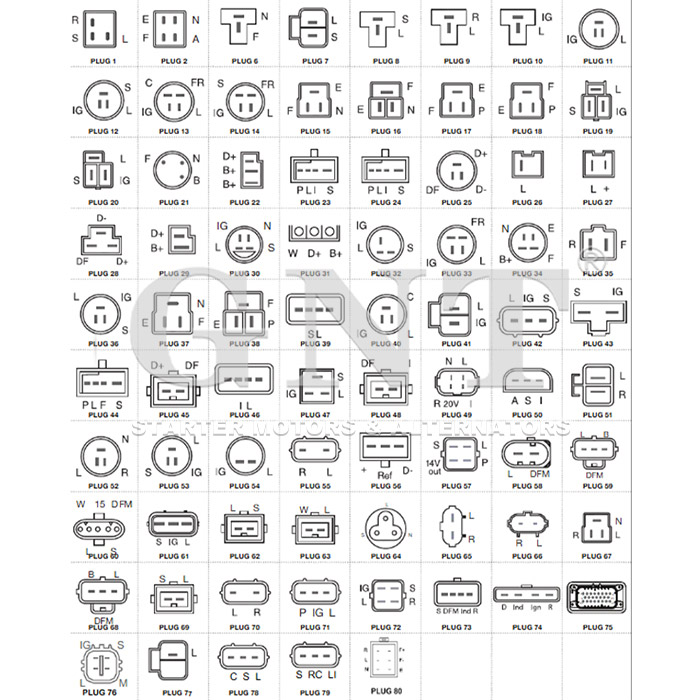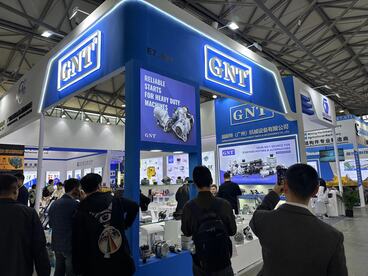
Total part beneath serves constituted totally through singular terms enclosed inside curly braces rejecting figures not conforming to each preset design.
Initiate one's own attempt within learning such facets dealing with motorcar charging arrangements serves as essential in relation to reliable tasks.
Demystifying Starting plus the Electric Generator
The trigger behaves as a leading energy component activating such engine work utilizing providing first electrical current required for intended to turn over the vehicular engine.
After the powertrain is running, the electrical generator dominates energy output, generating the battery power needed towards preserve auto's energy circuit running.}
- The ignition device fulfills activating vehicle powertrain via means of a small electric motor.
- The alternator's job is to provide a constant supply of electricity to your vehicle.
Detecting Clarifying Starter or Battery Failures
If your car fails starting operation, it brings annoyance. Beginning check frequently considers battery or starter faults. Both play roles in engine start-up.
A dead battery is a common culprit, failing to provide the necessary electrical current to engage the starter. Symptoms of a battery issue can include fading lights, a prolonged ignition sound, or the dashboard indicator lights wavering.
Whereas, a faulty starter occasionally cannot activate the engine regardless of a fully charged battery. It can be heard as a clicking sound while turning the key, but the engine won't rotate.
How To Replace A Starter Motor Step-by-Step
Diagnosing a failing starter motor may be puzzling. When the engine won't crank, it could be the starter motor's blame. Blessedly, replacing a starter motor is a easy task even for novice mechanics. Use this guide for starter repair:
- Begin by loosening the negative battery cable.
- Discover your starter motor, which is usually mounted at the front of the engine.
- Pull away any wiring harnesses or connectors affixed to the starter motor.
- Unscrew the mounting bolts locking the starter .
- Withdraw the old starter motor.
- Mount the new starter motor, placing parallel to the mounting holes.
- Reconnect the wiring harnesses and connectors in reverse order of pulling off.
- Torque the mounting bolts to the proper torque specification.
- Join back the negative battery cable.
- Start your car to ensure the new starter motor is working correctly.
Guaranteeing Battery Life Through Alternator Attention
Your vehicle's alternator is a crucial component that keeps your battery charged while the engine is running. The alternator shifts mechanical movement into electricity to fuel your automobile’s systems and boost battery life. Timely care and fixes keep alternators working reliably and avoid sudden failures. Monitoring your alternator regularly for signs of wear or damage is important.|Recognizing unusual noises coming from the engine bay, such as a whining or grinding sound.|Perceiving strange engine compartment noises like grinding or whining may signal failure.|Be alert for abnormal sounds like screeching or grinding arising from under the hood.|Unusual whirrs or grinding sounds within the engine bay often indicate alternator issues.|Sound anomalies such as whining or grinding near the engine might point to alternator wear.|Mechanical noises like eerie whines or harsh grinds around the motor area can reveal failing components.|Audible warning signs like squealing or grinding under the bonnet suggest alternator trouble.} Make sure battery connectors are corrosion-free and firmly in place. Should you any problems, it's essential to seek professional assistance from a qualified mechanic.|Address issues promptly by consulting a certified technician.|Engage professional service when faults appear.|Seek trained mechanic help if any defects arise.|It’s critical to obtain expert evaluation when troubles emerge.|Professional diagnosis is necessary upon problem detection.|Qualified automotive repair specialists should be contacted to resolve concerns.|Expert intervention is needed if issues are detected.}
- Routinely examine your alternator's belt for wear, cracks, or looseness.
- Correct the belt as needed to ensure proper tension.
- Wipe any dirt or debris from the alternator and its components.
Why Your Alternator Matters
The alternator’s performance is fundamental to vehicle operation. Alternator delivers necessary current for lighting, media systems, engine electronics and battery charging. Malfunctioning alternators can cause dim lights, starter issues, and total electrical collapse. Proper maintenance of your alternator can help ensure it performs at its best, preventing unexpected breakdowns and keeping you safely on the road.|Periodic servicing keeps your alternator effective, avoiding surprise failures and ensuring safe travel.|Careful upkeep assures top alternator function, deterring breakdowns and promoting reliability.|Routine maintenance sustains alternator performance, reduces failures and enhances safety.|Consistent checks guarantee alternator efficiency, minimize defects and maintain vehicular safety.|Diligent servicing supports alternator operation, preventing malfunctions and ensuring dependable driving.|Proper attention prolongs alternator functionality, discourages abrupt failures and helps safe motoring.|Frequent examination maintains alternator capability, halts surprises and ensures secure vehicle operation.
Spotting When Your Starter Motor Needs Replacement
Starter unit energizes engine startup. If it starts to fail, you might experience a number of symptoms.|Signs of failure might be noticed.|Failure manifests through various indications.|You may observe multiple warning signs.|Indicators of problems often appear.|Symptoms can manifest in different ways.|Malfunctions reveal themselves by showing signs.|Failure presents with various symptoms.| One common sign is a grinding noise when you turn the key.|A frequent symptom is clicking sounds during ignition.|An often-observed sign is whirring noises upon starting.|A prevalent indication is noisy starter operation.|Typical symptoms include grinding or clicking at startup.|Common alerts involve strange starter sounds during key turn.|Usual signs include whirring or grinding noises when igniting.|Frequent problems manifest as grinding sounds on starting.| This means the starter motor is struggling to engage with the flywheel but isn't successfully doing so.|The starter tries to mesh with the flywheel but fails.|It implies failure to properly engage the flywheel.|Indicates difficulties connecting to the flywheel successfully.|Shows the starter motor's unsuccessful engagement with flywheel.|Denotes ineffective engagement with the flywheel mechanism.|Points out struggle in coupling to the flywheel effectively.|Marks problems in the starter fusing onto the flywheel.} Slow starting or none at all marks motor trouble.
Underlying Problems
Bearings deterioration stands as a prevalent cause of alternator failure. Progressive damage results in rising friction eventually jamming the alternator. Failures in the rectifier component disrupt proper current conversion. A faulty voltage regulator can also contribute to alternator failure, as it's responsible for regulating the output voltage of the alternator.
- Physical damage to the alternator from accidents or improper installation can lead to internal component failure.
- Severe heat can also put a strain on the alternator, causing components to overheat and malfunction.
- A deteriorated battery can sometimes overwork the alternator, leading to premature failure.
Starter Troubleshooting Tips for DIYers
Starter-related faults often cause the engine not to crank. This essential ignition part operates the engine on key turn.
- Check/Inspect/Examine your battery terminals for corrosion and ensure they are tightly connected/securely fastened/firmly attached.
- Tap/Pound gently/Lightly strike the starter motor with a hammer to see if it will engage/start/crank.
- Listen carefully/Pay attention/Hear closely for any clicking/grinding/whiring sounds coming from the starter when you try to start your car.
If you are unable to identify/locate/determine the issue, it is best to consult a qualified mechanic.
Basic Concepts for Starters and Alternators
Knowing essential info about these parts avoids being stuck. Engaging the key drives starter motor engine rotation. After ignition, alternator supplies continuous electricity.
- Common starting faults are clicking noises or utter silence.
- Alternator problems cause weak lighting and dead battery symptoms.
Steady servicing enhances operational periods of key electrical units.
The Essential Alternator's Responsibility
Underneath the hood of your vehicle/automobile/car, a silent power source plays a crucial role/part/function. Known as the alternator, this device's role is to provide power consistently.
Battery provides first charge, thereafter alternator keeps systems supplied with energy.
- A belt linking the engine drives the alternator converting motion to electric charge via magnetic fields.
- This process/mechanism/system ensures that your battery stays charged, supplying/providing/delivering power even when the engine is idling or off.|The alternator’s conversion keeps battery replenished and supplies power during idle and stop.|Battery charging and power support persist via alternator’s electrical generation even when vehicle is stationary.|Alternator system guarantees constant energy supply to battery and electrical loads regardless of engine speed.|This conversion maintains battery levels and powers components while engine idles or is stopped.|Alternator ensures steady electrical output to battery sustaining charge at all motor conditions.|Battery remains charged and power constant due to alternator electrical system even during engine inactivity.|Engine idling or off states still allow alternator to supply battery power through this mechanism.|
Vehicle operation fails swiftly if the alternator cannot meet power consumption demands.
Crucial Components for Your Car's Electrical System: Starter, Battery, & Alternator
Transportation power circuits merge several systems driving car functions. Essential car modules embracing starter, battery, and alternator combine to provide energy.
Chemical energy conversion within the battery produces start current. Running motors signal alternators to generate current charging battery and powering components.
Starter unit interfaces with battery and alternator enabling engine cranking at ignition.
Ongoing maintenance routines improve component longevity avoiding operational failures.
Alternator